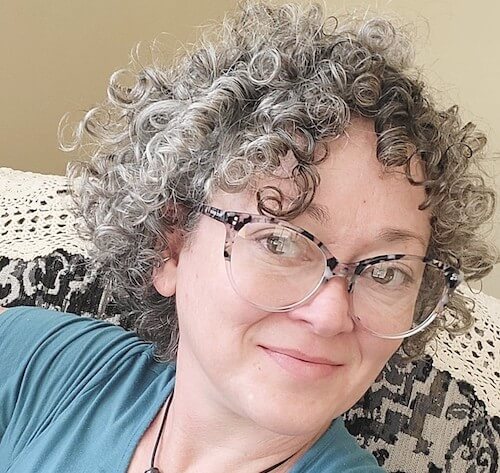Permanent wave and relaxer services are both called "perms" because they permanently alter the structure of the treated hair. But can these chemical treatments cause hair loss or lead to hair thinning? According to the experts, yes, they can. Fortunately, there are some hair care solutions to help rebuild and strengthen affected hair shafts.
VEGAMOUR spoke with an expert to explain how and why chemical-related hair loss occurs. Plus, discover how to help repair and restore chemically treated hair with vegan hair proteins.
What Is a Perm?
There are two different types of chemical hair services that are called "perm" for short. One is the permanent wave and the other is a hair relaxer. The former creates a curl structure and the latter shatters it, creating straightened hair. Both are caustic chemical services that are hard on the scalp and hair, which could lead to hair loss.
VEGAMOUR spoke with hair expert Gwenda Harmon of Power Your Curls about the importance of getting these services done by a professional to lessen hair loss associated with perming. "Perming is a harsh, drying process that penetrates the protective layer of your hair and alters its structure, so it must be done correctly and by hair professionals only or it might do irreversible damage to your hair," said Harmon. "Overuse, misuse and improper mixing of the chemicals can damage your hair follicles which will make them weak and brittle (leading to hair fall)."
Read More: What's Your Hair Texture and Hair Type? How to Find Out
Permanent Wave Treatment
A permanent wave involves wrapping small sections of hair on curling rods to give the hair a new shape, applying a chemical solution to break the hair bonds (sometimes using heat) followed by a second solution to re-set those bonds in their new shape. The result is a new curl pattern.
Perm chemicals offset the natural balance of your scalp biome due to the highly caustic alkalinity of the solution chemical's main active ingredient, ammonium thioglycolate. This throws off your scalp's delicate chemistry and causes scalp irritation which speeds up hair loss.
Perm solution also swells the hair strands and might lead to dryness, damage or breakage that will need protein and moisture treatment throughout the life of that permed hair. Split ends might also appear after a perm which will require regular trims to remove. Using any further chemicals, like hair color, hydrogen peroxide or bleaching, can worsen these effects on the hair. Follow-up care for permed hair is essential to restore the hair's integrity, health and shine.
Immediate Help for Your Permed Hair Loss
- After the first 24-48 hours you're free to shampoo your hair. Ask your stylist when you can resume regular home hair care following your perm appointment.
- Wash your permed hair with a shampoo that has vegan hair proteins in it. This will help to rebuild the proteins lost during the permanent waving process, improving the structural integrity of the hair.
- Follow with a nutritive conditioner to help replace the natural moisture that's been lost.
- Use a daily scalp serum to reduce hair fall and help to restore the natural scalp balance.
Read More: What Causes Sudden Hair Loss? 8 Possible Causes
Relaxers
Salons use lye-based relaxer solutions (sodium hydroxide) while weaker at-home formulas are calcium hydroxide or potassium hydroxide based. All relaxers are caustic because it takes a fairly strong chemical to break the bonds that keep your hair curly or kinky coily.
The high pH of relaxers puts you at risk for chemical burns which can cause hair loss, bald patches or even a scar. Always consult a professional for these services as they will know to use a protective cream around your hairline and on your scalp to protect your skin.
Before your relaxer service do not irritate, brush, scratch or stimulate the scalp as this can make your scalp more likely to burn. The relaxer solution is applied in small sections to the curly parts of the hair, processed and then rinsed out of the hair to create straight hair.
Typically you'll need to wait a week before shampooing the hair. A deep conditioning treatment is recommended periodically as long as you have relaxed hair on your head.
Further Reading: What Are Hair Plugs?
Are Perms and Relaxers Safe?
Relaxers, like curling perms, have risks to your skin and hair, including chemical burns, which could result in bald patches or permanent hair loss. Relaxer creams also affect your hair's follicle and shaft strength.
For a relaxer to work the bonds must be broken. In doing this there is a significant loss of proteins in the hair and a significant loss of moisture. Due to how these chemicals compromise the scalp's biome, they can also make you more susceptible to scalp irritations or infections, hair loss and hair thinning and breakage.
Consult with your stylist before getting a perm to be sure your hair is healthy enough to proceed. Be honest with them about any bleached hair or colored hair you have.
Related: What Is a Korean Hair Perm? Read This Before Getting One
Tips to Keep Your Permed Hair and Scalp Healthy
Thankfully, relaxed hair can be treated with vegan hair solutions to help restore damaged hair, address chemical-related hair loss and curb the hair thinning that sometimes follows these types of hair services. Follow these tips to improve the health of your permed hair:
-
Shampoo impurities out with VEGAMOUR'S GRO Revitalizing Shampoo.
-
Do a deep conditioning treatment with GRO Revitalizing Conditioner to shore up the strength of your thinning hair with plant-based proteins, restore moisture balance and help prevent breakage. Apply the conditioner liberally to the roots where the hair follicles are, down the shafts and through to the tips. Use a wide tooth comb to disperse the product, if needed. Wrap with a scarf to hold in body heat and keep the product from dripping. Process for about a half hour and rinse with tepid water.
-
Use a daily hair serum to help maintain the health of your scalp and hair. This targeted serum provides support and nutrition right at the base of the hair follicles to encourage healthy looking hair.
-
Heat is often used to dry the hair and press it into silky-straight hairstyles. Use heat protection sprays or creams to reduce further damage and to shape frizzy strands around the hairline and nape.
Read More: 5 Things You Should Avoid If You Have Thinning Hair
Know the Risks When Getting a Perm
When you choose to get a permanent curling or straightening service, know the risks of using these types of chemicals on your head and your hair type. If you choose these services, it's good to know there are reparative treatment solutions including shampoos, conditioners, serum treatments and even supplements you can take to help care for your permed hair.
#include-related-slider#
More From VEGAMOUR
- Shop: The Best Products for Dry Hair
- How and Why to Plop Your Curly Hair
- How to Sleep With Curly Hair
- Why Does My Bottom Layer of Hair Get So Tangled?
Photo credit: Tima Miroshnichenko/Pexels



















